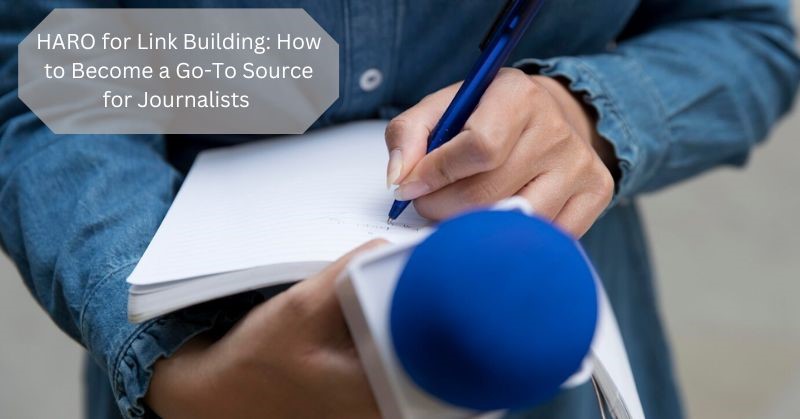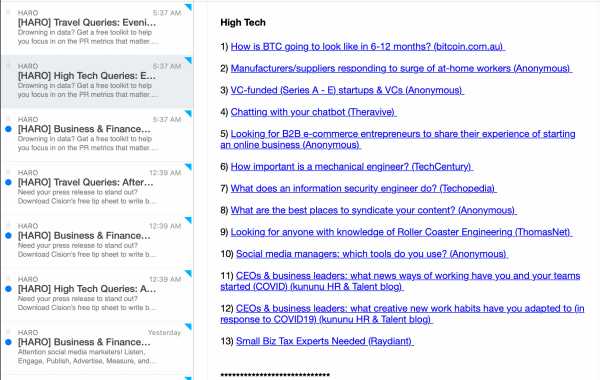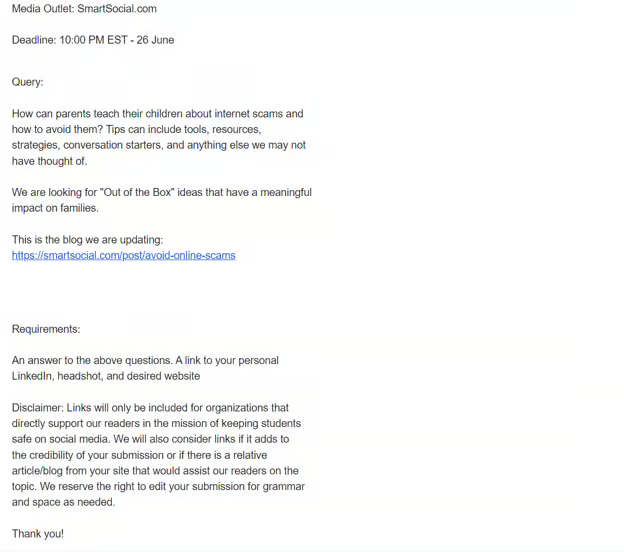
Guest posts, broken link building, influencer outreach, and social media sharing – you must be familiar with all these link-building strategies.
But have you heard about HARO?
HARO, or Help a Reporter Out, helps journalists connect with sources for their stories. It is a game-changer for boosting digital marketing efforts.
This strategy helps you get your name and brand mentioned in high-profile articles, gaining relevant traffic to your website. Though free, HARO requires a robust approach to leverage its potential.
You must work hard to become a trusted source and yield substantial returns. When used correctly, HARO link building can generate high-quality backlinks for your website, boosting it to the top of search engines.
Continue reading till the end to learn and understand how to leverage HARO for link-building success.
What is HARO
einsteinmarketer.com/haro-content-marketing/
HARO (Help a Reporter Out) is an online platform founded by Peter Shankman in 2008. It is a valuable resource for journalists and experts.
Journalists can gain reliable insights for their stories, while experts can establish themselves as industry leaders and gain media exposure.
The platforms send daily emails to their subscribers, list journalists’ questions, and look for experts’ opinions, quotes, or data on different matters.
Benefits of Using HARO for Link Building
Some of the key advantages of using HARO for link building are listed below:
- High-quality Backlinks: Getting featured in articles by reputable media outlets provides high-quality backlinks to your website, improving its overall SEO.
- Increased Domain Authority: Consistently getting backlinks from authoritative sites enhances your domain authority, raising the possibility of ranking higher in search engine results.
- Enhanced Credibility and Trust: Being referred to as an expert in popular publications increases your credibility in the eyes of customers and possibly other industry players.
- Boost in Traffic: Backlinks from other quality sites boost your website’s traffic since people who follow these links seek a professional opinion in their niche.
- Networking Opportunities: HARO boasts a network comprising more than 75,000 journalists and bloggers, alongside over 1 million sources. Interacting directly with journalists and media professionals means getting more opportunities and partnership offers.
Setting Up for Success
1. Selecting Suitable Queries
einsteinmarketer.com/haro-content-marketing/
HARO outreach necessitates very broad thinking about your expertise. You rarely receive a 1:1 question for a precise niche; therefore, shoulder niches will require the most of your marketing.
Consequently, if your website is about nutrition, you can target any query that falls under the health and wellness area. Determining which link chances are important will be quite subjective, so you’ll just have to analyze each list of requests as they come in and sort of play it by ear.
2. Take a Close Look at the Query
startupgeek.com/blog/haro/
Paying close attention to details is crucial. When a reporter from HARO Links asks a question, they will receive dozens, even hundreds of responses. You will lose the chance if you cannot comply with their fundamental requirements.
Read the question through from beginning to end, then reread it. Some queries may even have a secret phrase inserted in the middle, asking you to respond with a secret word.
This assists reporters in identifying individuals who are simply skimming the inquiry rather than reading it entirely.
3. Check If You Can Obtain High-quality Backlinks
When you look through the list of HARO queries, you can see which publication requests the pitch in brackets next to the topic.
It’s best to review the queries you could respond to in advance. You ought to submit a pitch to those queries if you can obtain high-quality links from respectable websites like Forbes or any other major news outlet.
Requests for information can sometimes be made anonymously. You have a very limited possibility of getting backlinks from this because you never know where your quote is going to be used!
4. Draft a Converting Pitch
Making a solid pitch is the next stage in successfully developing HARO links.
Given that one out of every four journalists receive over 100 emails each week, many of which are useless, they only respond to approximately 3.27% of all pitches. Business leaders must thus give top priority to making sure that their pitches are pertinent to journalists’ requirements and interests.
If all you’re doing in your HARO response is repeating what everyone already knows, chances are the journalist is aware of the same information, and you have nothing fresh to contribute to their piece.
Journalists use the HARO approach to obtain fresh perspectives and ideas for their articles. Therefore, you must be really imaginative and have a fresh perspective.
5. Take Quick Action
The backlink belongs to the early bird. Journalists frequently receive the information they require in the first few responses and work under strict time constraints.
Because of this, you must reply as soon as possible to improve your chances of getting featured. HARO distributes emails to its registered users three times daily: at 5:35 a.m., 12:35 p.m., and 5:35 p.m. Eastern Time.
If you’re serious about developing HARO links, you should reorganize your schedule around these hours to be the first to answer.
6. Add Your Details
By providing your name, location, title, contact details, website URL, and other relevant information, you make it as simple as possible for the journalist to cite or use you as a source.
You will be less likely to be cited by a reporter as an authority if they must find this information themselves.
7. Follow Up
Your original pitch may be lost or ignored in the thousands of emails journalists receive daily. A courteous and professional follow-up email might remind them of your offer and convey your sincere desire to be a part of their story.
Give yourself a reasonable time window—roughly two to three days—before reaching out again with your pitch. Briefly restate your main ideas and convey your excitement about contributing to their piece.
Do not appear pushy or irritated; instead, be polite and considerate. Conclude the email correspondence with a last expression of gratitude and your contact details for convenient access.
Points to Be Kept in Mind with HARO
- Read the query carefully to determine what the journalist needs. Focus on any particular questions or details they might ask.
- If the journalist has provided specific instructions, such as format, word length, or extra information, make sure your response meets these guidelines. Omitting such aspects can give your presentation a messy and unpolished feel, which is unfavorable.
- In your quest to add value to the discussion, do not answer any questions that are not pertinent to your field. Giving irrelevant or inconsequential information augments your time and dials down your reliability when dealing with journalists.
- Concentrate on providing accurate, meaningful, and valuable content relevant to a journalist’s question. Give out information and insight about your field, but don’t directly promote yourself or your business.
- Although it might be helpful to dwell on specific achievements, do not ramble on about your qualifications. The less you solicit your brand or company, the better; bring it up only when necessary and when it would be helpful.
Conclusion
Using HARO for link building is the key to improving online visibility and positioning as a source of information for journalists.
Effective profile creation, constant scanning for requests, time spent composing meaningful answers, and adherence to the rules will help you get valuable backlinks and increase your domain’s authority.
Also, sharing the stories you pitched through HARO makes you more credible and gives you more opportunities to reach the media. If done with due diligence and strategy, HARO can revolutionize your link-building game and yield substantial, sustainable results for your brand.

About the author: Vibhav Gaur, Business Head
Vibhav Gaur leads strategic operations and business growth at the organization. With a strong background in digital transformation and customer-focused solutions, he has helped numerous clients streamline their web presence and scale efficiently. His leadership ensures seamless execution across teams, with a commitment to delivering results and fostering innovation in every project.






